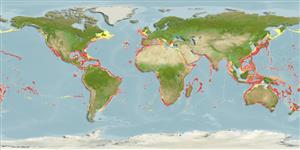Environment: milieu / climate zone / depth range / distribution range
Ecologie
marien benthopelagisch; oceanodroom (Ref. 51243); diepte 100 - 975 m (Ref. 9302), usually 200 - 400 m (Ref. 6181). Subtropical; 55°N - 43°S, 180°W - 180°E (Ref. 6181)
Circumtropical and temperate seas of the world.
Grootte / Gewicht / Leeftijd
Maturity: Lm ? range ? - ? cm
Max length : 300 cm TL mannelijk / geslacht onbekend; (Ref. 5951); common length : 150 cm SL mannelijk / geslacht onbekend; (Ref. 6181); max. gepubliceerd gewicht: 63.5 kg (Ref. 4699)
Dorsale stekels (totaal): 13 - 15; Dorsale zachte stralen (totaal): 15-18; Anale stekels 0; Anale zachte stralen: 15 - 18; Wervels: 32. Skin very rough, scales interspersed with spinous bony tubercles. Mid-ventral (abdominal) keel on the ventral contour. Body is uniformly brown to dark brown, tips of the pectoral and pelvic fins black, margins of the second dorsal and anal fins white in young specimens.
Usually over the continental shelf, sometimes in oceanic waters down to 800 m (Ref. 9302). Usually solitary or in pairs near the bottom (Ref. 6181). Migrates far offshore (Ref. 26139). Pelagic (Ref. 5951). Feeds on fish, crustaceans and squid (Ref. 6181). The peculiar wooden 'palu' or Ruvettus hook is used to catch this species in south central Pacific (Ref. 6181). The flesh is very oily, with purgative properties, if eaten much (Ref. 6181). Marketed fresh and as fish cakes in Japan (Ref. 9302); also processed into fishmeal (Ref. 5217). Maximum length reported to reach up to 2 m only (Heemstra, pers. comm. 03/03).
Levenscyclus en paargedrag
Maturiteit | Voortplanting | Paaien | Eieren | Fecunditeit | Larven
Nakamura, I. and N.V. Parin, 1993. FAO Species Catalogue. Vol. 15. Snake mackerels and cutlassfishes of the world (families Gempylidae and Trichiuridae). An annotated and illustrated catalogue of the snake mackerels, snoeks, escolars, gemfishes, sackfishes, domine, oilfish, cutlassfishes,. scabbardfishes, hairtails, and frostfishes known to date. FAO Fish. Synop. 125(15):136 p. (Ref. 6181)
Status op de Rode Lijst van het IUCN (Ref. 130435)
Gevaar voor de mens
Poisonous to eat (Ref. 4690)
Gebruik door de mens
Visserij: van minder commercieel belang; sportvis: ja
Meer informatie
ReferentiesAquacultuurAquacultuurprofielKweeklijnenGeneticaElectrophoresesErfelijkheidZiektesVerwerkingNutrientsMassaconversie
Tools
Speciale rapporten
Download XML
Internetbronnen
Estimates based on models
Preferred temperature (Ref.
123201): 8.6 - 19, mean 12.9 °C (based on 603 cells).
Fylogenetische diversiteitsindex (Ref.
82804): PD
50 = 1.0000 [Uniqueness, from 0.5 = low to 2.0 = high].
Bayesian length-weight: a=0.00347 (0.00191 - 0.00629), b=3.10 (2.93 - 3.27), in cm total length, based on LWR estimates for this species & (Sub)family-body (Ref.
93245).
Trofisch niveau (Ref.
69278): 4.2 ±0.57 se; based on food items.
Weerstandsvermogen (Ref.
120179): laag, minimale populatieverdubbelingstijd 4,5-14 jaar (Assuming tm>4).
Prior r = 0.28, 95% CL = 0.16 - 0.49, Based on 1 stock assessment.
Fishing Vulnerability (Ref.
59153): Very high vulnerability (90 of 100).
Climate Vulnerability (Ref.
125649): Moderate vulnerability (38 of 100).
Nutrients (Ref.
124155): Calcium = 17.3 [7.8, 32.2] mg/100g; Iron = 0.573 [0.271, 1.108] mg/100g; Protein = 17.7 [15.5, 19.7] %; Omega3 = 0.202 [0.110, 0.353] g/100g; Selenium = 81.8 [36.6, 171.9] μg/100g; VitaminA = 10.3 [3.2, 36.7] μg/100g; Zinc = 0.411 [0.288, 0.611] mg/100g (wet weight);
